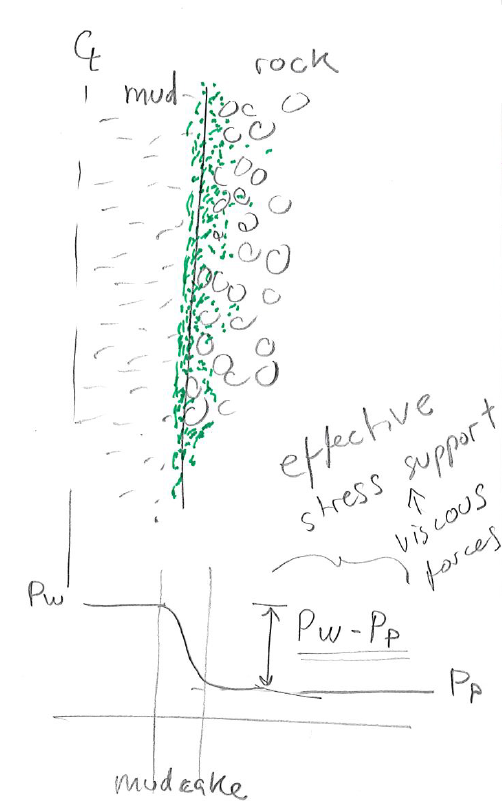Wellbore stability is critical for drilling.
A stable open-hole requires the surrounding sediment and rock to bear the stresses concentrated around the cavity.
The surrounding rock must hold stresses until casing is set or for undetermined time if left uncased.
Wellbore stability depends on two set of variables: one set out of our control and another set that we can control.
- In-situ variables out of our control include far-field stresses
 , pore presssure
, pore presssure  , and rock properties.
, and rock properties.
- Controllable variables include mud pressure
 , mud composition, mud chemistry, and wellbore orientation (direction azimuth and deviation).
, mud composition, mud chemistry, and wellbore orientation (direction azimuth and deviation).
The pressure in the wellbore  is one of the main variables to maintain wellbore stability.
Mud (mass) density and vertical depth
is one of the main variables to maintain wellbore stability.
Mud (mass) density and vertical depth  (TVD) determine the mud pressure (in the absence of additional pressure controls at the surface). Thus
(TVD) determine the mud pressure (in the absence of additional pressure controls at the surface). Thus
 |
(6.1) |
The pressure gradient in the wellbore mud is
 (Fig. 6.1).
This quantity is usually measured and reported in p.p.g. (pounds-force per gallon).
For example the density of fresh water is 9800 N/m
(Fig. 6.1).
This quantity is usually measured and reported in p.p.g. (pounds-force per gallon).
For example the density of fresh water is 9800 N/m , about 8.3 ppg.
The lithostatic gradient of 1 psi/ft is equivalent to 18.9 ppg.
, about 8.3 ppg.
The lithostatic gradient of 1 psi/ft is equivalent to 18.9 ppg.
Figure 6.1:
Wellbore mud pressure and equivalent circulation density. Mud pressure  is usually reported in terms of gradient (depth-independent) rather than in absolute values.
is usually reported in terms of gradient (depth-independent) rather than in absolute values.
|
Over-balanced drilling implies  .
Over-balanced drilling favors the formation of a “mud-cake” on the wall of the wellbore which permits adding stress support on the wellbore wall approximately equal to
.
Over-balanced drilling favors the formation of a “mud-cake” on the wall of the wellbore which permits adding stress support on the wellbore wall approximately equal to  (Fig. 6.2).
The resulting effect is similar to an impermeable and elastic membrane applying a stress on the wellbore wall (similar to the membranes used in triaxial tests).
Under-balanced drilling
(Fig. 6.2).
The resulting effect is similar to an impermeable and elastic membrane applying a stress on the wellbore wall (similar to the membranes used in triaxial tests).
Under-balanced drilling  may be preferred in some specific instances.
may be preferred in some specific instances.
Figure 6.2:
Leak-off of mud filtrate favors clogging of mud particulates which help apply a normal stress on the wellbore wall. This layer of particulates is called mud-cake.
|
 , pore presssure
, pore presssure  , and rock properties.
, and rock properties.
 , mud composition, mud chemistry, and wellbore orientation (direction azimuth and deviation).
, mud composition, mud chemistry, and wellbore orientation (direction azimuth and deviation).





![\includegraphics[scale=0.65]{.././Figures/split/7-ECD.pdf}](img655.svg)



